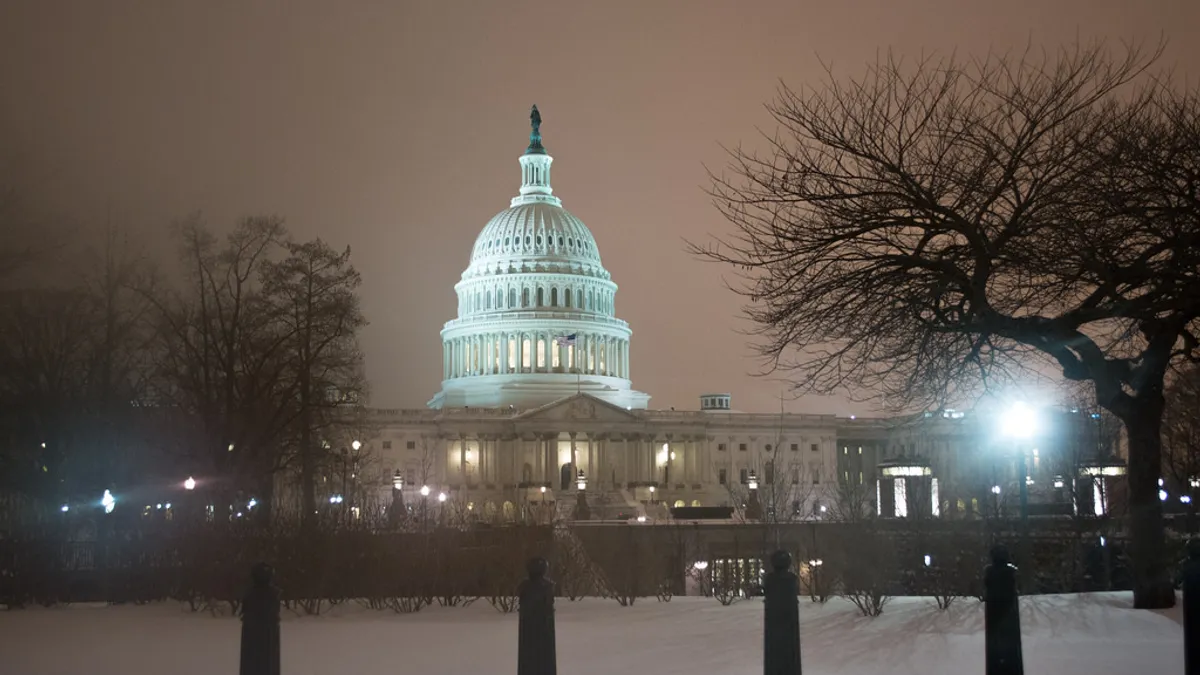Dive Brief:
- A combination of a federal clean energy standard, a technology-neutral tax credit, a carbon pricing approach and transmission regulation reforms is the "most effective scenario" in which the U.S. achieves dramatic greenhouse gas emissions reductions by the middle of the century, the American Council on Renewable Energy (ACORE) said in a report released Thursday as House Democrats prepare a sweeping piece of legislation intended to achieve nationwide net-zero emissions by 2050.
- The House Energy & Commerce Committee released a framework on Wednesday laying out the major provisions of the CLEAN Future Act, a planned bill that would combine a federal Clean Electricity Standard with measures like energy efficiency targets for buildings, a national climate bank proposal and incentives for electric vehicle charging infrastructure.
- The ACORE report advocates overhauling the way the federal government approaches electric transmission, but the CLEAN Future Act framework does not currently address the transmission siting and permitting process.
Dive Insight:
With this new legislative framework, House Democrats are focusing their climate-related efforts on the goal of a 100% clean energy economy by 2050.
According to ACORE, removing carbon dioxide-emitting sources from U.S. electricity by 2050 will require 30 GW of renewable power capacity added each year from 2020 to 2050, which would be a 50% increase in the current growth rate of renewables.
The CLEAN Future Act framework, which is the product of months of hearings held by House subcommittees, has several major policy planks. These include what is essentially a federal renewable portfolio standard that would require all retail electricity suppliers to obtain 100% of their electricity from clean energy sources by 2050.
Other major components include a national target for improving building codes so more buildings can be net-zero-energy and the creation of a national bank that would finance clean energy projects like low emissions technologies and industrial decarbonization.
ACORE's report included a federal standard among its provisions, but also called for a streamlining the federal permitting process for large renewable energy projects and a production or investment tax credit similar to those implemented for wind and solar but made available for all clean energy technologies. A Senate bill introduced by Sen. Ron Wyden, D-Ore., last year proposed such a credit, and ACORE cited that legislation as a potential model to follow in future bills.
Environmental group Earthjustice called the Committee's draft framework "a first step" toward legislation that will be formally introduced later this year. An Earthjustice spokesperson said that the group is unsure yet if a Senate version of the CLEAN Future Act will be introduced.
The Natural Resources Defense Council praised the framework as "a far-sighted plan" that "sends a message that we need to move, and rapidly, to a future powered by clean energy and transportation sources."
One area where the framework appears to be a work in progress is transmission siting and permitting.
It mentions directing the Federal Energy Regulatory Commission to consider climate change impacts in its decisions, as well as expanding the stakeholder process at FERC. But "although these measures will modernize and strengthen the transmission system, they do not include overarching reforms to the transmission permitting and siting process," the framework said.
The ACORE report cited research concluding that the transmission grid needs to be greatly expanded in order to integrate large amounts of renewable energy without imposing costs on consumers.
"These findings underscore how building out regional and interregional transmission can complement other climate policies by enabling greater, and more cost-effective, renewable energy penetration," the report said. One way to incentivize more private sector investment into transmission would be for FERC to shift "from a risks and challenges framework, which encourages costly and risky projects, to a benefits framework, which would incentivize projects in line with their consumer value," ACORE suggests.
The CLEAN Future Act still needs to be refined and unaddressed issues like transmission siting should ultimately be part of comprehensive climate legislation, the House committee said, calling for more hearings and stakeholder engagement to help include more provisions in the ultimate bill.














